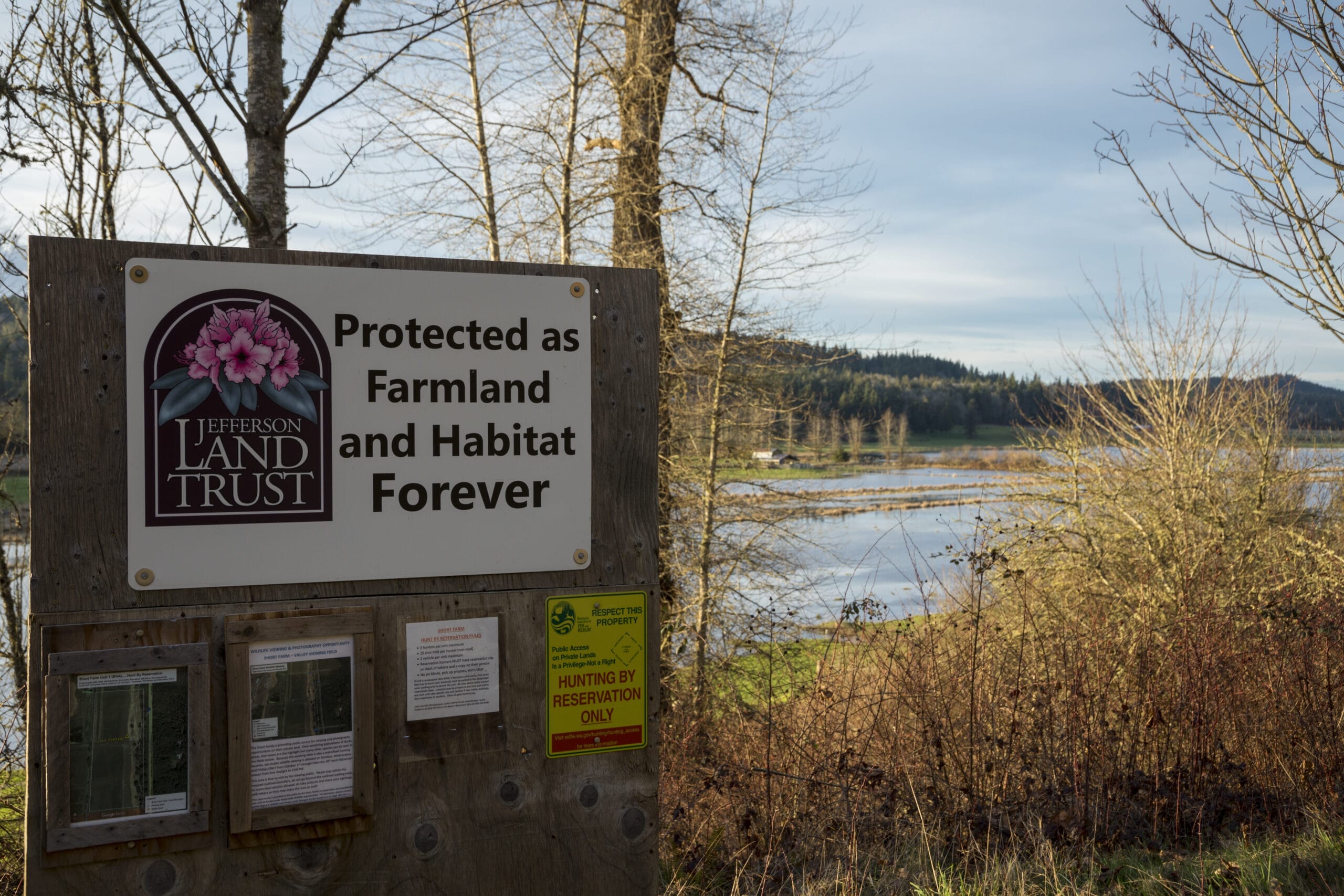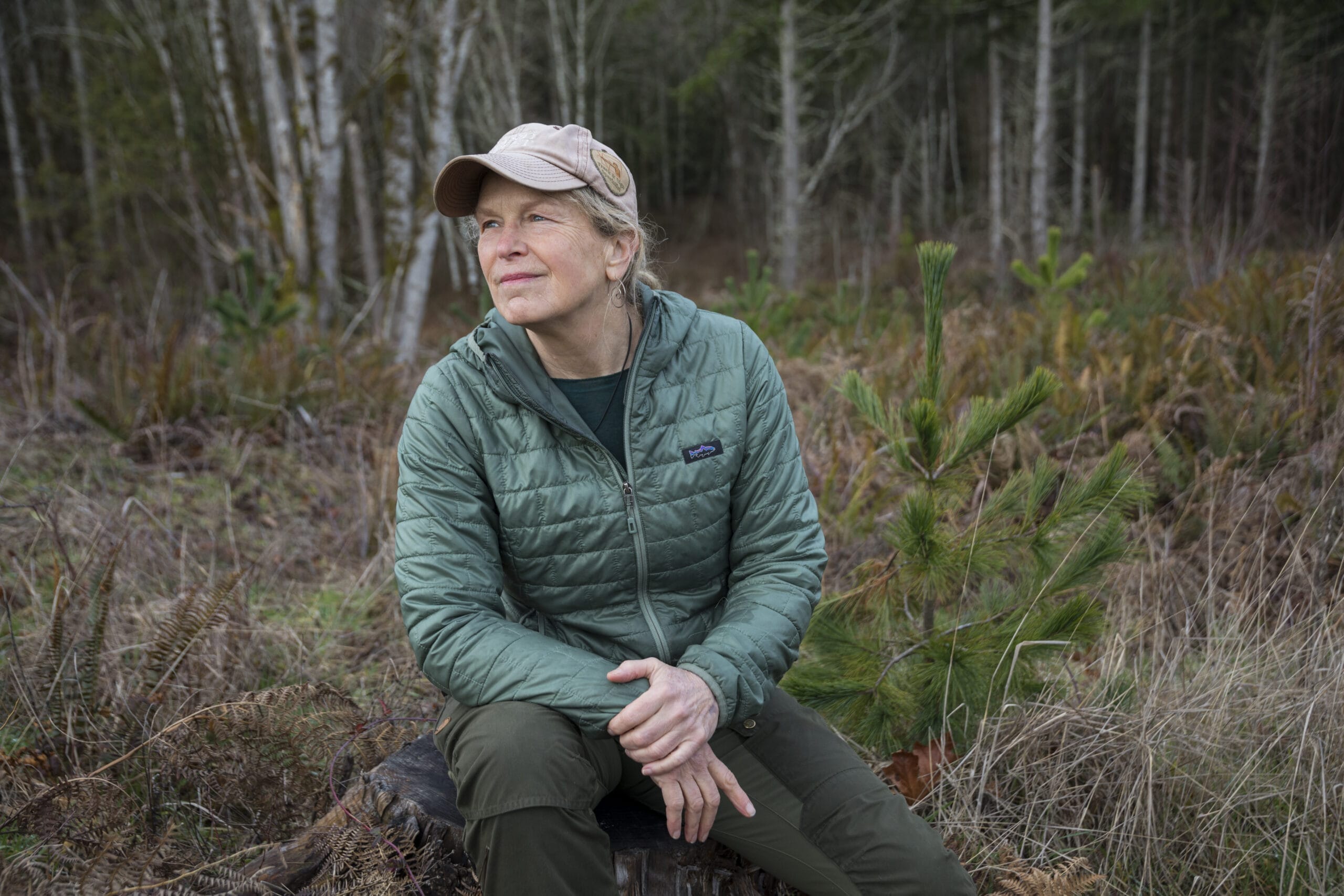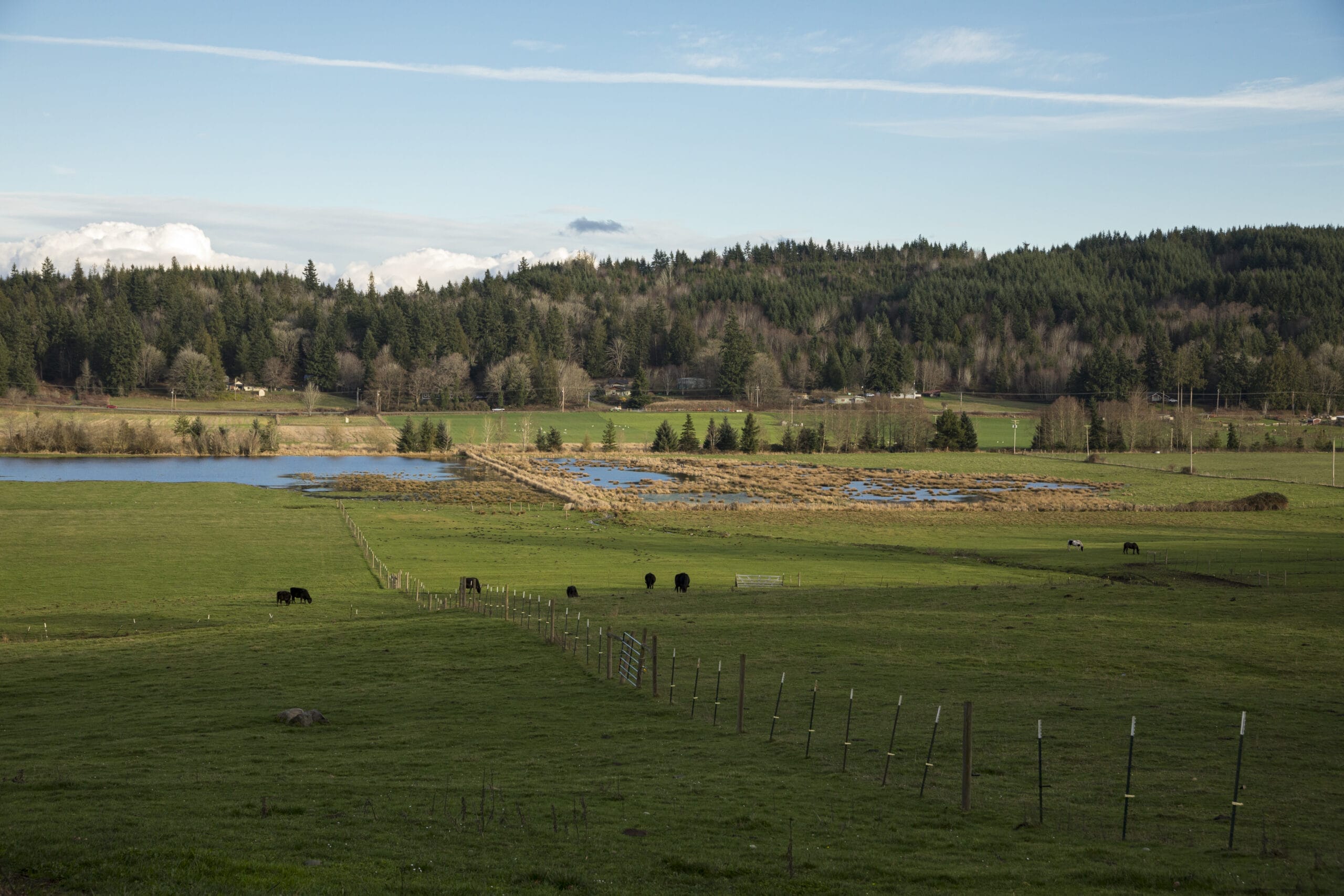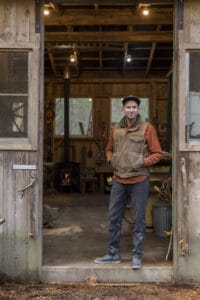On a brisk afternoon, the earthiness of damp leaves and pine needles perfuming the air, Sarah Spaeth surveys the 853-acre forest in Chimacum, Washington, that her organization, Jefferson Land Trust, recently acquired with TPL’s help. “We’ve got cedar, we’ve got maple, we’ve got some spruce coming in,” she says, looking pleased as her footfalls trace an old logging road that cuts through the property. “In the far-off corner where you see the tree line—there’s a
native cranberry bog down in there.”
For contrast to that natural diversity, she points out the remnants of the forest’s recent past, when Douglas firs were planted so densely the branches were stunted and a fungal disease, laminated root rot, was allowed to spread. Years ago, a patch that had been clear-cut was replanted with a monoculture of “Doug fir,” as locals call it, the ultralucrative source of lumber that thrives here on the Olympic Peninsula in Washington State. “They wanted those tall skinny firs with no branches,” Spaeth says, referring to the timber company that previously owned the land. “But we want a diversity of trees that have more green growth and get bigger in girth.”
Richard Corff, TPL’s senior director of field programs, walks alongside Spaeth, gesturing toward the healthy understory of huckleberry shrubs and ferns. He notes that in negotiating the purchase terms, TPL and Jefferson Land Trust arranged for two conservation easements (or deed restrictions) on the property, respectively. One prevents any future real estate development. The other lays out a series of rules regarding future timber harvests, letting trees grow longer, for instance, and allowing for a variety of tree species.
“That will create longer harvest rotations that are not only productive but incredibly healthy for the forest,” Corff explains. “It will ultimately create landscapes that store a lot more carbon too.”
An earlier owner had considered selling to a developer that envisioned building a subdivision. Trust for Public Land worked with Jefferson Land Trust to protect and ultimately buy the property, now called Chimacum Ridge Community Forest. Instead of adding houses, lawns, and paved streets, crews are busy blazing trails on the property. They’ll soon be available to the public for healthy pursuits such as hiking, fishing, birdwatching, horseback riding, and mountain biking.
Unlike a lot of conserved lands, however, this property also doubles as a working forest. The model, with Jefferson Land Trust poised to harvest trees sustainably, preserves a way of life that has dominated this scenic stretch west of Seattle for generations. It protects logging and milling jobs. It provides locally sourced timber for woodworkers and craftspeople in the region. And it demonstrates an ecologically sensitive approach to managing timberlands.
A lighter touch—logging less frequently and thinning trees rather than clear-cutting—reduces the threat of erosion and holds huge climate and environmental benefits. Without runoff from lawns and streets, creeks that support salmon on either side of Chimacum Ridge will remain clear and cold. And carbon stored in the forest will stay largely put.
Working Lands Are Conservation Lands
In the public imagination, conservation groups look to protect undeveloped land by locking it up for wildlife habitat and maybe allowing the public a toehold for recreation. Indeed, Trust for Public Land often conserves lands that become state and local parks or that get added to existing national parks or wildlife refuges that include broader public access for recreation.
But that approach isn’t best for every community or landscape. Working farms, ranches, and timberlands are cornerstones, economically and culturally, of the nation’s diverse regions. Yet with populations rising in recent decades, development
has swallowed many of these working lands.

TPL works with local partners to protect land in perpetuity—that is, forever. Photo: Tegra Stone Nuess
Open space and good-paying jobs have given way to shopping centers, subdivisions, and road networks. That, in turn, has consequences for the environment and public health, with aquifers becoming depleted, streams contaminated, and wildlife corridors blocked. In addition, the amount of time and tailpipe emissions required to transport products to market increases. For the public, the erasure of working landscapes can mean the collateral loss of recreational access to woodlands—access often granted informally by timber companies.
“Most of the communities where we focus our energy rely on working lands for their economic well-being, as well as their identity.”
–David Patton, TPL national Lands initiative director
Although Jefferson Land Trust wound up purchasing the Chimacum Ridge property, most working land projects are achieved through conservation easements, in which timber companies or ranchers sell or donate their development rights. Those deals are cheaper than buying land outright, and as a result, we can protect more acreage.
“Most of the communities where we focus our energy rely on working lands for their economic well-being, as well as their identity,” explains David Patton, TPL’s national Lands initiative director. “Imagine if you were to take 50,000 acres and cut them up into 40-acre mansion lots. You would have a much different environment than if you retain an intact ecosystem. People continue to benefit from those jobs, and residents and tourists continue to use the land, whether for hunting or fishing or hiking.”

— Sarah Spaeth, director of conservation and strategic partnerships at Jefferson Land Trust
A Cornucopia of Benefits
Trust for Public Land has protected hundreds of thousands of acres of working lands across the country in recent decades. Much of that conservation has centered on the West, with its vast stretches of coniferous forests and fertile grasslands.
In Colorado, we’ve protected a half dozen ranches in the Upper Arkansas Valley, ranging in size from 400 to 3,200 acres. In the nearby Gunnison Valley, located four and a half hours southwest of Denver, TPL was part of a coalition that protected Trampe Ranch, whose operation comprises a fifth of Gunnison County’s agricultural economy.
At 6,000 acres, Trampe Ranch extends from the city of Gunnison to beyond Mount Crested Butte. Its protection yielded a cornucopia of benefits: Beautiful, wide-open spaces attract visitors that sustain the area’s outdoor recreation economy. Scientists from the Rocky Mountain Biological Laboratory conduct research there, including studies on climate change. And animals such as sage-grouse, elk, mule deer, black bears, and mountain lions consider the ranch home.
Conserving this ranchland also saved some of the most striking scenery in Colorado. “Trampe Ranch is in view of some of the state’s most epic trails and the ski runs of the Crested Butte Mountain Resort,” notes Jim Petterson, TPL’s Mountain West region vice president and Colorado and Southwest director. “So, from a visitor standpoint, we are preserving the outdoor experience for people who ski, mountain bike, camp, and hike in the wider region.”
Perhaps nowhere are our ambitions greater than in Montana. We recently pledged to protect a million acres of land through our Forever Montana campaign in response to rising development pressures there. That is on top of a half million acres we had already protected in the state, as well as in northern Idaho, most of it in the form of working forests.
“We have a choice. We either conserve these working forests, or their fate will be death by a thousand driveways. That’s the crossroads we’re at. The development pressures will not abate.”
– Dick Dolan, TPL Northern Rockies director
Some protected timberlands were transferred to the U.S. Forest Service and the Montana Department of Natural Resources and Conservation, agencies that permit some logging. But the majority have remained in the hands of timber companies such as Stimson Lumber, Green Diamond Resource Company, and F.H. Stoltze Land and Lumber Company. Conservation easements on these lands require that timber harvesting be done in accordance with certified sustainability protocols.
Regardless of ownership, the forests are available for public recreational use, and their protection ensures that watersheds and habitats will remain intact for centuries to come. “If you scope out far enough, you’ll see that our conservation efforts protect almost all the private forests across northern Montana, knitting these ecosystems together,” explains Dick Dolan, TPL’s Northern Rockies director. “The valleys are still private because that’s where people live. But essentially, all the uplands will be conserved. Not every last acre, but if you look at the map, it’s a very large contiguous area.”
One project that stands out for both its size and grandeur is the Kootenai Forestlands. A few years ago, TPL and our partners conserved 50,000 acres in the northwest corner of Montana. There, the rugged Cabinet Mountains are carpeted with Douglas firs, white pines, and ponderosa pines, while free-flowing rivers teem with rainbow trout and bull trout. Stimson Lumber continues to employ local residents in sustainable timbering jobs. Wildlife benefits from the protection of the 133-mile border between the timberlands and the Kootenai National Forest. And the public, meanwhile, has a seemingly endless playground in which to hunt, fish, forage, and hike.
Such is Montana’s popularity that in 2021 the state boasted the most expensive residential property sale in the nation. That’s when media magnate Rupert Murdoch plunked down $200 million for a 340,000-acre ranch (more than twice the size of Chicago) in southern Montana, near Yellowstone National Park. As further evidence of the runaway market, Dolan says some land prices in the area have tripled in the past three years.
“We have a choice,” says Dolan, referring to Kootenai Forestlands and other projects in the pipeline. “We either conserve these working forests, or their fate will be death by a thousand driveways. That’s the crossroads we’re at. The development pressures will not abate.”

From Eelgrass to Orcas
Back in Washington State, real estate interest continues to seep west from Seattle and Tacoma into the Olympic Peninsula and environs. The 3,600-square-mile peninsula presents a diverse ecosystem, with glacier-topped peaks, temperate rainforests, and an expansive coastline. Much of it is protected, thanks to Olympic National Park and Olympic National Forest.
But a large swath of open space between Olympic National Park and Seattle—studded with farms, forests, and even a fjord—is being eyed for residential development. “A town like Bremerton in Kitsap County has grown dramatically,” observes TPL’s Richard Corff. “People commute to Seattle from there, which they didn’t use to do.”
In recent years, TPL has completed a string of conservation projects that together boost the region’s recreational appeal, economic vitality, and climate readiness. In fact, lands protected by TPL on the Olympic Peninsula capture nearly 37,000 metric tons of carbon annually, roughly equivalent to emissions from 30,000 gas-powered vehicles driven for one year.
In 2015, Trust for Public Land led an effort to protect some 6,300 acres of working forest along the Dosewallips and Duckabush Rivers, between Olympic National Forest and Hood Canal. In 2020, also on Hood Canal, we conserved more than 2,100 acres of the Dewatto Headwaters Forest, a timberland on the Kitsap Peninsula.
That same year, TPL completed a landmark conservation project at the southern reach of Puget Sound totaling 20,400 acres. Stretching from Case Inlet to Hood Canal, the South Puget Sound Coastal Forest will remain in active timber production, protected from development and accessible to the public forever. Another bonus: the landowner, Green Diamond Resource Company, manages the land under a habitat conservation plan that seeks to protect 51 aquatic and terrestrial species.
Then there was Camp Hahobas. The 430-acre site, a pristine expanse of mature forest and streams on the shores of Hood Canal, was a longtime Boy Scout camp. An hour west of downtown Seattle, Hood Canal is not a manmade canal at all, but a dramatic inland waterway that draws millions of visitors a year. It is also the only true fjord in the lower 48 states. On a clear day, the snowy peaks of the Olympic Mountains are reflected in its calm waters.
In 2019, TPL helped protect the Boy Scout property, transferring part of it to the Great Peninsula Conservancy, a nonprofit group. The conservancy now oversees Hahobas Shoreline Preserve, the portion of the former camp that includes a half mile along Hood Canal, where beds of eelgrass sway in the water. The state manages the rest of the property as a working forest, with revenues supporting public schools.
A key ecological reason for protecting the shoreline from development was preservation of the natural edge. “When the shoreline is armored with retaining walls, you degrade the habitat and you lose that eelgrass,” says Nathan Daniel, the conservancy’s executive director, while maneuvering an aerial photography drone over the preserve. “All these things are interconnected. The resident orca whales feed on the adult salmon, particularly the Chinook, and the Chinook, in turn, eat smaller forage fish that live in the eelgrass. The nutrients coming off the land feed the eelgrass too.”
Habitat protection is foundational to Jefferson Land Trust’s stewardship of Chimacum Ridge, as well. Recently, Spaeth, who is a certified wildlife tracker, found a cougar kill-site at one end of the property, with deer the target. Maintaining open space is critical for large animals such as cougars, also called mountain lions, that range over huge territories.

Forest Manager Ryen Helzer works to clear downed trees from a trail on Chimacum Ridge. Photo: Tegra Stone Nuess
Local Material, Local Identity
In fact, biodiversity will inform the forest’s management plan, which Jefferson Land Trust recently hired someone to oversee and implement. Richard Tucker is executive director of the land trust and formerly served as a Trust for Public Land attorney and interim state director of Georgia. “We want an older forest,” he says of Chimacum Ridge. “We want mixed species. We want mixed ages. And we want woody debris and snags.”
Tucker also hopes to turn Chimacum Ridge Community Forest into a living classroom, instilling an appreciation of forests in children and adults alike. For adults, the land trust already offers guided nature walks and workshops on the ABCs of using a chainsaw. For youngsters, Tucker envisions expanding the school groups that now visit the property to something deeper. “Port Townsend has a maritime curriculum where kids learn how to sail,” he says, referring to the city on the northeast tip of the Olympic Peninsula. “We could have a working-landscape curriculum for students in Chimacum, where they learn about forestry and agriculture, as well as related products and careers.”

Woodworker Cody Wayland, whose workshop is in Port Townsend, uses locally sourced timber as much as possible. Photo: Tegra Stone Nuess
To be sure, local woodworkers are looking forward to the first harvest from Chimacum Ridge Community Forest. Cody Wayland, a sawyer, furniture maker, and homebuilder in Port Townsend, strives to use locally sourced tree species whenever possible. That lumber might wind up being a bit more expensive than farther-flung, industrially extracted timber, but he thinks it’s worth it. “It’s hard for some clients to choose local lumber for something they will never see, like a stud inside a wall,” he allows. “But for me, when I go into a building that has that connectivity to the place or the land it sits on, I find it much more satisfying.”
“When I go into a building that has that connectivity to the place or the land it sits on, I find it much more satisfying.”
– Cody Wayland, local woodworker
Betsy Davis, executive director of the Northwest School of Wooden Boatbuilding, agrees. The school, in Port Hadlock, educates 40 to 60 students a year in the skills and artistry required to become a successful boat builder. Instructors even lead student groups into the woods so they can see the living trees before they become boats.
Douglas fir and western red cedar are favored materials, but generally the trees need to grow for an unusually long time before they’re harvested. Davis plans to ask Jefferson Land Trust to set aside an acre or two of trees that are left to grow for hundreds of years. “We are trying to be sensitive to our carbon footprint, so the more we can source our wood locally, the better,” she says. “I think it’s amazing for a community to have a working forest, especially a community that places such a premium on craftsmanship.”
Spaeth, who directs conservation and strategic partnerships for Jefferson Land Trust, makes the analogy to the local food movement that took off in the 1980s, when people began to think and care about the origins of what they eat. “The relationship we have with local food—we want to have that with timber,” she explains.
To encourage this, the land trust did a pilot project a few years ago: it offered local nonprofits and lumber mills a free tree from its Valley View Forest, the 65-acre property adjacent to Chimacum Ridge. “We did a small harvest and said, ‘We’ll cut down the tree if you haul it away,’” she recalls. The uptake was good.
The event showed there is an appetite for local wood and raised awareness about what’s possible. “We’d like to see that chain of timber stay local,” says Spaeth. With groups like Trust for Public Land working to keep forests functioning with and for their communities, there is a much better chance it will.
Lisa W. Foderaro is a senior writer and researcher for Trust for Public Land. Previously, she was a reporter for the New York Times, where she covered parks and the environment.

Donate to become a member, and you’ll receive a subscription to Land&People magazine, our biannual publication featuring exclusive, inspiring stories about our work connecting everyone to the outdoors.


